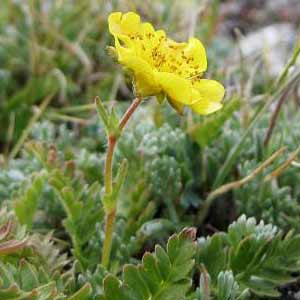Geum rossii
(synonym of Geum rossii var. depressum)
Geum macrophyllum
Ross' avens
benoîte à grandes feuilles, bigleaf avens, large-leaf avens
4–28 cm, glabrous or downy, hairs to 1 mm, sometimes septate-glandular.
30–110 cm, puberulent and hirsute or sparsely hirsute.
basal 3–13 cm, blade pinnate to interruptedly pinnate, major leaflets 13–26, alternating with 0–14 minor ones, terminal leaflet slightly larger than major laterals;
cauline 0.7–2 cm, stipules adnate to leaf, indistinguishable from pair of lobes, blade bractlike, not resembling basal, alternate, simple, pinnatifid to 3-fid.
basal 10–45 cm, blade interruptedly lyrate-pinnate, major leaflets 5–9, alternating with 4–15 minor ones, terminal leaflet usually much larger than major laterals;
cauline 2–12 cm, stipules ± free, 7–23 × 3–12 mm, blade lyrate-pinnate, pinnate, 3-foliolate, or simple and 3-lobed.
1–3(–4)-flowered.
3–16-flowered.
woolly, sometimes glandular.
densely puberulent, sometimes with scattered longer hairs, sometimes stipitate-glandular.
erect;
epicalyx bractlets 1.5–7 mm;
hypanthium green, slightly purple-tinged to strongly purple;
sepals erect to erect-spreading, 3–10 mm;
petals spreading, yellow, obovate to nearly orbiculate, 5–12(–17) mm, longer than sepals, apex broadly rounded to irregularly emarginate.
erect;
epicalyx bractlets often absent, 0.5–2 mm;
hypanthium green;
sepals erect-spreading but soon reflexed, 2.5–5.5 mm;
petals spreading, yellow, obovate, broadly elliptic, or suborbiculate, 3.5–7 mm, longer than sepals, apex rounded.
sessile, glabrous.
sessile or on less than 1 mm stipes, puberulent.
wholly persistent, not geniculate-jointed, 2–5(–10) mm, apex not hooked, glabrous throughout or pilose only at base.
geniculate-jointed, proximal segment persistent, 2.5–6 mm, apex hooked, sparsely to densely stipitate-glandular, distal segment deciduous, 1–2 mm, pilose in basal 1/3, hairs much longer than diam. of style.
= 56.
Geum rossii
Geum macrophyllum
The variability accommodated here in Geum rossii was distributed by earlier monographers such as P. A. Rydberg (1913b) and F. Bolle (1933) among a half dozen species. W. Gajewski (1957) reduced them to two species, G. rossii and G. turbinatum; most recent taxonomists have recognized the two taxa as subspecies or varieties of a single species. The large geographic discontinuity between the Rocky Mountain and arctic ranges makes it easy for those wishing to follow this tradition. No one morphologic character or combination of characters neatly separates the arctic plants from those of the Rockies.
Where their ranges overlap in Alaska, Geum rossii hybridizes with G. calthifolium to form sterile plants known as G. ×macranthum (Kearney ex Rydberg) B. Boivin; see discussion under 4. G. schofieldii.
(Discussion copyrighted by Flora of North America; reprinted with permission.)
Varieties 2 (2 in the flora).
Characters useful in recognizing specimens of Geum macrophyllum are yellow petals, epicalyx bractlets often absent, proximal style segment sparsely to densely stipitate-glandular, and fruiting receptacles puberulent. Across its broad North American range from Alaska to California and Nova Scotia, G. macrophyllum exhibits considerable variation. Based largely on the shape of the terminal leaflet of the basal leaves and the degree of dissection and shape of the divisions of the distal cauline leaves, P. A. Rydberg (1913b) distinguished three species within the range of variation treated here as one species. Basal leaves of G. macrophyllum in the strict sense (var. macrophyllum in this treatment) have relatively large reniform to rounded terminal leaflets and the distal cauline leaves are three-cleft into rhombic or cuneate lobes. The basal-leaf terminal leaflets of G. perincisum (= var. perincisum) are only slightly larger than the laterals and are deeply lobed into rhombic-obovate segments; the distal cauline leaves are dissected into oblanceolate divisions. Both basal and cauline leaves of G. oregonense (= var. perincisum) are intermediate between those of G. macrophyllum and G. perincisum. W. Gajewski (1955) crossed all three taxa under discussion and examined leaf morphology and cytology of the F1 and F2 hybrids. He concluded that they were distinct but not yet completely separated species. Fairly well correlated with the more dissected leaves of G. oregonense and G. perincisum is the presence of minute stalked glands on the pedicels. The treatment here follows H. M. Raup (1931) in recognizing two varieties of G. macrophyllum based more on pedicel glandularity than leaf morphology.
(Discussion copyrighted by Flora of North America; reprinted with permission.)
1. Pedicels not glandular-puberulent; cauline leaves with distal simple and 3-lobed (divided less than 3/4 to base), lobes rhombic-oblong. | var. macrophyllum |
1. Pedicels glandular-puberulent; cauline leaves with distal 3-foliolate or simple and 3-lobed (divided almost to base), lobes oblanceolate to obovate. | var. perincisum |
- Local floras:
BC,
OR,
WA
- Local Web sites:
CalFlora,
CalPhotos,
Flora NW,
PNW Herbaria
WildflowerSearch
iNaturalist (observations)
USDA Plants Database
- LBJ Wildflower Center
- SEINet
- Plants of the World Online
- Encyclopedia of Life
- Wikipedia
- Google Image Search
- Local floras:
BC,
CA,
OR,
WA
- Local Web sites:
CalFlora,
CalPhotos,
Flora NW,
Go Botany,
MI Flora,
MN Wildflowers,
PNW Herbaria,
SW CO Wildflowers,
Turner Photog.
WildflowerSearch
iNaturalist (observations)
USDA Plants Database
- LBJ Wildflower Center
- SEINet
- Plants of the World Online
- Encyclopedia of Life
- Wikipedia
- Google Image Search


